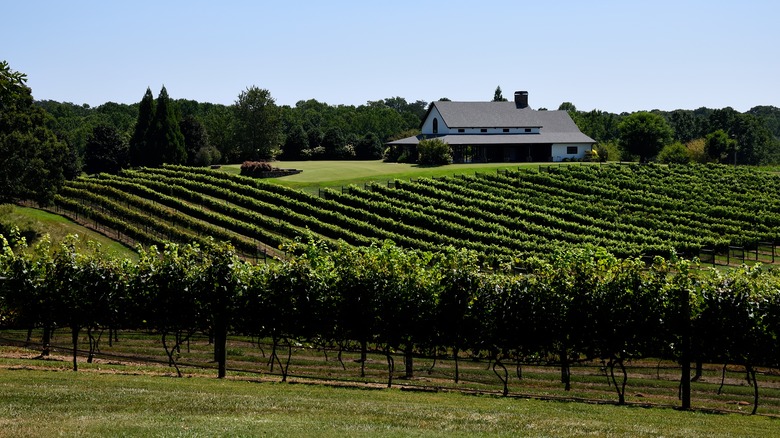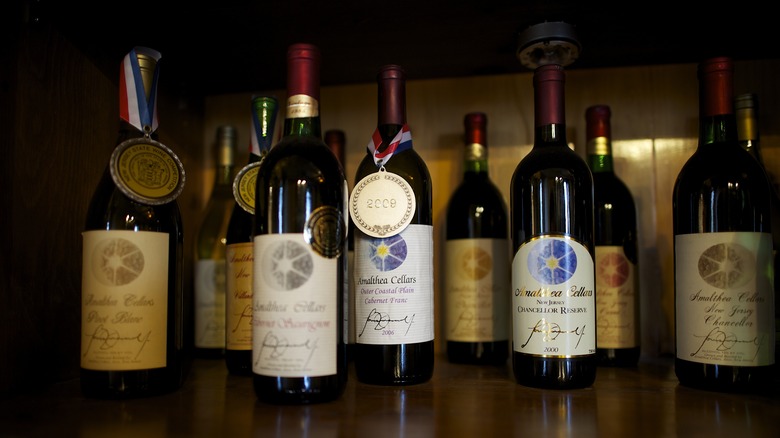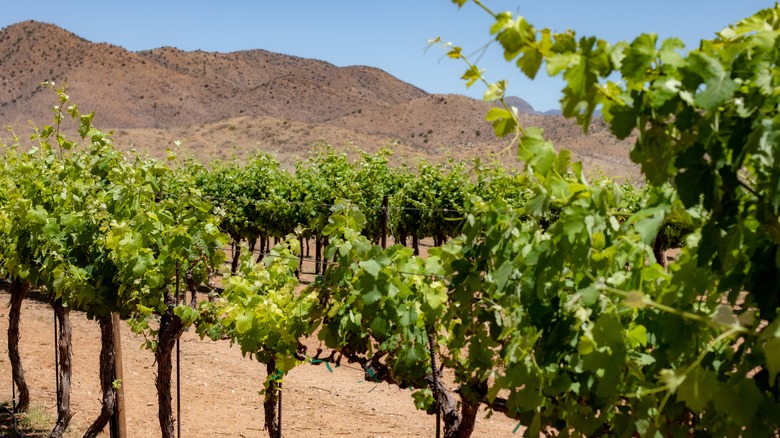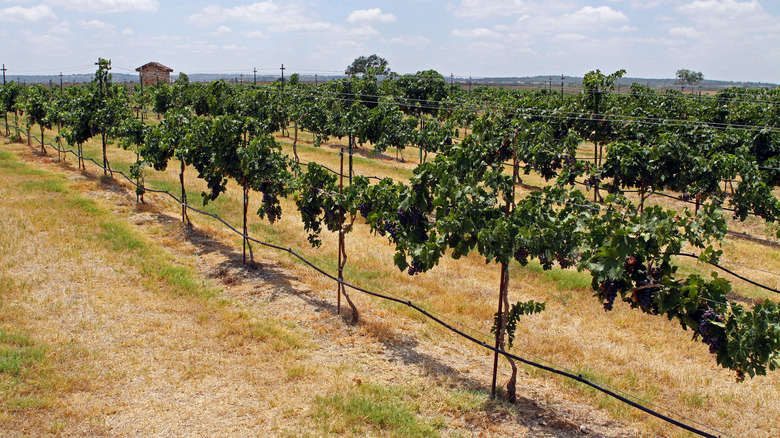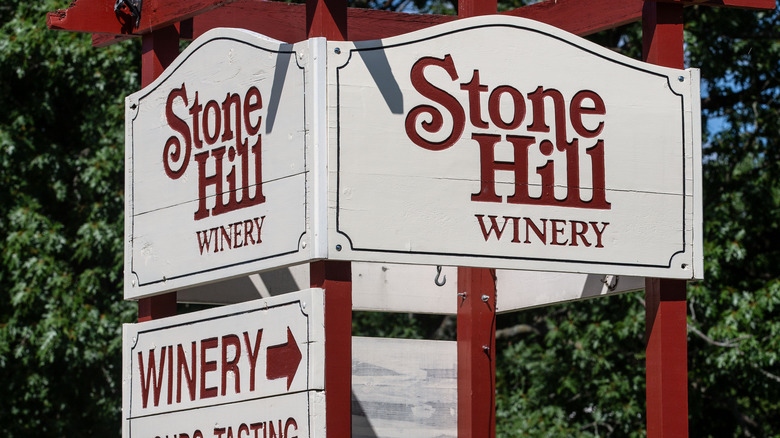The Most Underrated Wine Regions You'll Find In The US
There's Napa Valley with its cabernet sauvignon and chardonnay, the New York Finger Lakes with riesling, and Oregon with its pinot noir. These are American wine regions we know and love. But woven across the land are underrated wine metropolises you may have missed.
According to the Alcohol and Tobacco Tax and Trade Bureau, currently, the United States has 270 American Viticultural Areas (AVAs). These areas are designated lands in the country recognized for their wine-grape growing potential. It means the areas have ideal climates and soil types for vineyards and have distinct characteristics for high-quality wine. It's a similar principle to the Appellation d'Origine Contrôlée regions of France or Denominazione di Origine Controllata regions of Italy.
California alone is home to 150 AVAs, such as the Russian River Valley AVA, making it the largest winemaking region in the country. That's probably not a surprise considering California's reputation for winemaking. However, that means the rest of the 120 AVAs are scattered throughout the United States in locations you probably wouldn't have ever associated with high-quality winemaking. Guided by the expertise of Henna Bakshi, a certified wine expert with a Level 3 qualification from the Wine & Spirit Education Trust, we've explored this list of AVAs and the variety of vineyards within them to select the most underrated wine regions in the United States. If you're ever passing through Georgia, New Jersey, Arizona, Texas, or Missouri, it's definitely worth it to take a trip to a local winery.
Georgia
Just an hour and a half drive north of Atlanta are the Blue Ridge Mountains, home to orchards, vineyards, and waterfalls. The region is an oasis compared to the city, and winemaking is a way of life for locals here. As a state, Georgia has two AVAs: Dahlonega Plateau and Upper Hiwassee Highlands. In fact, most of the vineyards in the Upper Hiwassee Highlands are located in North Carolina. However, because North Carolina has a better reputation for wines, Georgia wineries in the area are sometimes overlooked despite producing many of the same grapes and wines as their North Carolina counterparts. For this reason, the Peach State made our list of under-the-radar wine regions.
Muscadine is Georgia's native grape (different from the Scuppernong grape) and is capable of making dry, off-dry, and sweet wine with bruised apple, banana, and citrus flavors. This region also produces other hybrids like traminette (an intensely aromatic and floral white wine), norton (a punchy red wine), and chardonel (which tastes like a zippy chardonnay). The wines pair beautifully with the local cuisine, like shrimp and grits, blueberry pie, and fried catfish.
If you're in Atlanta, book a tour from the city to the vineyards. Many guided bus tours are available that shuttle you through a lineup of vineyards. Cabin rentals with mountain views are available for overnight stays. For first-timers, check out award-winning wines at Yonah Mountain Vineyards, Three Sisters Vineyards, or Montaluce Winery and Restaurant. If you're looking to stay closer to Atlanta, head to Cloudland Vineyards and Winery to experience one of the few vineyards practicing organic farming.
New Jersey
When you visit New Jersey, wine may not be at the top of your mind. But believe it or not, the state is an incredible and budding wine region. There are over 50 wineries growing many varieties of grapes, such as riesling and pinot noir, as well as popular Italian varieties like sangiovese and barbera. French American hybrids and native American vines are also grown here.
Winemaking is taken seriously in New Jersey. This state has four AVAs: the Outer Coastal Plain, Warren Hills, Central Delaware Valley (shared with eastern Pennsylvania), and the Cape May Peninsula. Currently, New Jersey is gaining popularity for its sparkling wines in particular. According to the Garden State Wine Growers Association, New Jersey was once as renowned as the Champagne region of France prior to Prohibition, and within the last 20 years, local wineries have started embracing these sparkling roots. Vineyards like William Heritage make quality blanc de noir and blanc de blanc sparkling wines. Hawk Haven Vineyard and Winery makes a brut blanc de blanc and rosé sparkling wine. But if red wines are more your speed, Amalthea Cellars Winery has plenty of award-winning selections.
Arizona
Wine in the desert? Believe it! Arizona is a great place for vineyards. The Grand Canyon State's hot and dry climate helps ripen grapes with ease. Moreover, there are very high elevations in Arizona — some vineyards are as high as 5,200 feet above sea level (per the Arizona Wine Growers Association), making for cool microclimates. A mix of sun and cooler temperatures from the elevation produce an excellent crop of grapes.
Currently, Arizona has three AVAs: Sonoita, Willcox, and the Verde Valley. Winemaking in Arizona dates back to the 1600s, but it only recently started getting some major attention. With more than 100 wineries, the state grows a variety of grapes similar to those grown in Italy, Spain, and southern France, including grenache, syrah, mourvedre, tempranillo, and sangiovese, among others. The distinct climate in Arizona's high elevations is also great for aromatic whites like riesling, roussanne, and viognier.
Wineries like Alcantara Vineyards and Rune Wines offer award-winning wines with sweeping backdrops of the desert. Want to explore several wineries in a day? The Verde Valley Wine Trail has a whole collection worth visiting.
Texas
It's no surprise Texas is doing it big. The Lone Star state is home to eight AVAs, located mainly across central and west Texas: Texas Hill Country, Texas High Plains (which is responsible for 80% of the state's wine grape production), Bell Mountain, Fredericksburg in the Texas Hill Country, Escondido Valley, Mesilla Valley, Texas Davis Mountains (with elevations as high as 8,300 feet), and Texoma. It's one of the most exciting wine regions in the country right now, growing from about 20 wineries in the 1980s to more than 450 today, according to Dallas News. That is a huge boom in winemaking, and one worth exploring.
It's hot in Texas, and you might wonder how in the world wine grapes do well here. Mediterranean-style Spanish grapes and hybrids are grown to tackle the state's heat and humidity. About 70% of the production is red wine. Tempranillo, lomanto, black Spanish, muscadine, mourvèdre, and viognier (among others) are popular varieties, and they all do well in this climate. Try the local red wines the next time you order Texas BBQ; they make for a brilliant match.
To get a taste of the state's vast array of wine, head to the Texas Wine Collective, located on the 290 Wine Trail in the Texas Hill Country. The collective represents three winemakers: Brennan Vineyards, Lost Oak Winery, and McPherson Cellars. The tasting room is equipped to offer food and wine pairings, Texas cheese pairings, and educational tastings in a gorgeous setting.
Missouri
We saved the oldest for last. Long before California, Missouri was the wine capital of the country. The very first AVA was established in Missouri more than 40 years ago in 1980. Due to the highly-coveted glacial soil that was found in Missouri at the time — which was ideal for ripening grapes — the Augusta AVA was the first distinction awarded in the United States. Napa Valley followed suit eight months later in California.
Today, Missouri is home to five AVAs in total: Augusta, Ozark Mountain, Hermann (home of the award-winning Stone Hill Winery), Ozark Highlands, and Loess Hills District. And Missouri makes a whole lot of wine, selling 1.6 million gallons of wine every year (via Food & Wine).
Much like Georgia, Missouri is also known for growing hybrid grapes like catawba, chambourcin, chardonel, concord, norton, seyval blanc, and more. With more than 125 wineries to explore, the state has eight wine trails, including the Hermann, Kansas City, and the Lake of the Ozarks trails. For the history buffs, you must check out Augusta's oldest winery, Mount Pleasant Estates, which was established in 1859.
It's often said that wine is made in the most beautiful places on Earth, and that includes American vineyards. There are many underrated wine regions to explore across the country. As you travel, look into the local wine scene and head to the vineyards. You may be pleasantly surprised to find a hidden nook of beauty, and the perfect glass of wine to unwind with.

